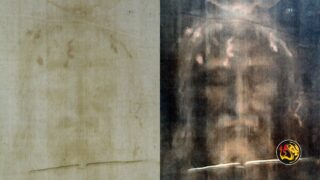Italian Experts: ‘Evidence About Jesus’ Burial Clothing
By Stefan J. Bos, Chief International Correspondent Worthy News

ROME/BUDAPEST (Worthy News) – Italian researchers have reopened the 600-year-old debate over the Shroud of Turin, the linen cloth that some believe was used to wrap the body of Jesus after his crucifixion.
Using a technique called Wide-Angle X-ray scattering, scientists from Italy’s Institute of Crystallography claim to have discovered new evidence that the shroud dates back to Jesus’ life.
In a study published in the journal Heritage, the authors shared dating work on a sample from the Shroud and concluded that it may be a 2,000-year-old relic.
While the latest study does not reveal whether or not the artifact was indeed Jesus’ burial shroud, the authors did find that its age is roughly consistent with his time.
The findings challenge previous research backing a medieval origin of the Shroud, one of the most studied archaeological objects in the world.
The Shroud of Turin, also known as the Holy Shroud, is 4.3 meters (14 feet 3 inches) long and 1.1 meters (3 feet 7 inches) wide.
BROWN IMAGES
It has long been the subject of intense scrutiny: features of a faint image of a man that some believe is the body of Jesus miraculously imprinted onto the cloth.
The shroud portrays two faint, brown images of a man 5 feet 7 inches tall, seen from the front and the back.
Believers in the shroud claim that “these images are evidence” that this is the very piece of cloth used to wrap Jesus’ body after his death.
Other Bible-believing Christians would argue that the shroud should not become the basis of faith in Jesus Christ, who told the disciple Thomas in John 20:29, “Because you have seen me, you have believed; blessed are those who have not seen and yet have believed.”
According to historical records, the shroud first appeared in 1354 in France.
After initially denouncing it as “a fake,” the Catholic Church embraced the shroud as genuine.
The first evidence of the shroud’s existence emerged in 1354 when it appeared in the possession of a knight named Geoffroi de Charnay.
FAKE SHROUD?
At the time, the local bishop reportedly denounced the shroud as “a fake” and claimed a local artist had painted it.
Yet, by the 1400s, the shroud’s authenticity was taken for granted, and it became an object of worship.
In December 1532, when its chapel burned down, the shroud was extensively damaged by fire and water, and the material had to be repaired with patches.
However, centuries later, the mystery surrounding the Shroud of Turin continues to attract worldwide attention.
💡 Did you know? One of the best ways you can support Worthy News is by simply leaving a comment and sharing this article.
📢 Social media algorithms push content further when there’s more engagement — so every 👍 like, 💬 comment, and 🔄 share helps more people discover the truth. 🙌
Latest Worthy News
If you are interested in articles produced by Worthy News, please check out our FREE sydication service available to churches or online Christian ministries. To find out more, visit Worthy Plugins.
